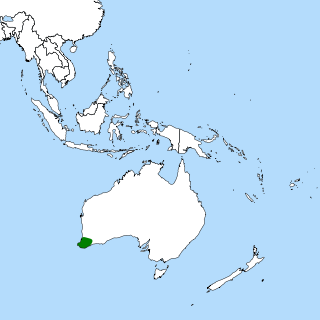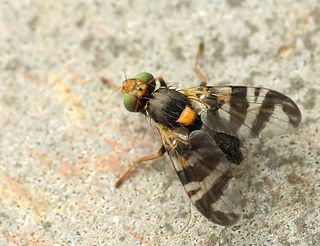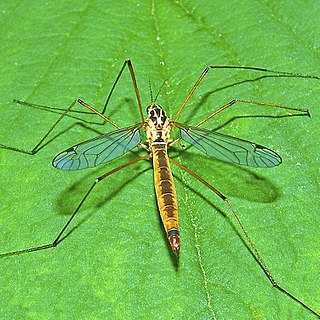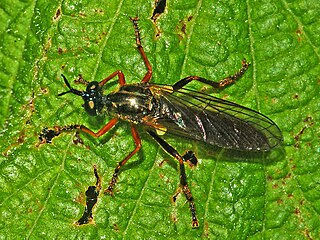
The Micropezidae are a moderate-sized family of acalyptrate muscoid flies in the insect order Diptera, comprising about 500 species in about 50 genera and five subfamilies worldwide,. They are most diverse in tropical and subtropical habitats, especially in the Neotropical Region.

The Neriidae are a family of true flies (Diptera) closely related to the Micropezidae. Some species are known as cactus flies, while others have been called banana stalk flies and the family was earlier treated as subfamily of the Micropezidae which are often called stilt-legged flies. Neriids differ from micropezids in having no significant reduction of the fore legs. Neriids breed in rotting vegetation, such as decaying tree bark or rotting fruit. About 100 species are placed in 19 genera. Neriidae are found mainly in tropical regions, but two North American genera occur, each with one species, and one species of Telostylinus occurs in temperate regions of eastern Australia.

Badisis is a stilt-legged fly genus with only one known species, Badisis ambulans. This is a wingless, haltere-less fly with an ant-like appearance. It is only found in the Southwest Australian bioregion of Western Australia. Dependent on the rare Albany Pitcher Plant for its development, this fly is also a rare species.

Chrysotoxum bicinctum is a species of hoverfly.

Rhagoletis cerasi is a species of fruit fly in the family Tephritidae.

Phaonia pallida, the muscid fly or orange muscid fly, is a species of fly in the family Muscidae.

Empis tessellata is a species of dance fly, in the fly family Empididae. It is included in the subgenus Euempis.

Atherix ibis, the yellow-legged water-snipefly, is a species of ibis flies belonging to the family Athericidae, a small family very similar to Rhagionidae.

Ibisia marginata, the black-legged water-snipefly, is a species of ibis flies belonging to the family Athericidae, a small family very similar to the Rhagionidae.

Psila fimetaria is a species of fly, member of the family Psilidae.
Diptera is an order of winged insects commonly known as flies. Diptera, which are one of the most successful groups of organisms on Earth, are very diverse biologically. None are truly marine but they occupy virtually every terrestrial niche. Many have co-evolved in association with plants and animals. The Diptera are a very significant group in the decomposition and degeneration of plant and animal matter, are instrumental in the breakdown and release of nutrients back into the soil, and whose larvae supplement the diet of higher agrarian organisms. They are also an important component in food chains.

Meiosimyza rorida is a species of small flies of the family Lauxaniidae.

Neoitamus cyanurus, the common awl robberfly, is a species of 'robber fly' belonging to the family Asilidae.

Nephrotoma cornicina is a species of fly in the family Tipulidae.

Bibio hortulanus, common name marchfly, is a species of fly from the family Bibionidae.

Rainieria is a genus of stilt-legged flies in the family Micropezidae. There are at least 20 described species in Rainieria.

Micropeza corrigiolata is a species of stilt-legged flies in the family Micropezidae.

Rainieria antennaepes is a species of stilt-legged flies in the family Micropezidae found in North America east of the Rocky Mountains. The name "antennaepes" means "antenna foot". They frequently hold their white-tipped front legs up and wave them around in a manner that makes them appear like the antennae of ichneumonid wasps. They feed on detritus, bird droppings, and similar waste.

Dioctria rufipes, the common red-legged robberfly, is a species of robber fly in the subfamily Dasypogoninae of the family Asilidae.

Choerades marginata is a species of robber fly found in Europe.



















